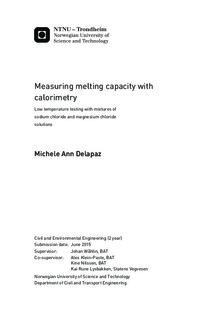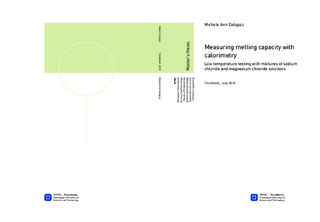| dc.description.abstract | Salt application is an important part of winter maintenance activities. As the use of salt increases, there is a need for usage optimization due to environmental impacts. For deicing purposes an important property is the chemical s melting ability; i.e. its ice-melting capacity. As several chemical alternatives and additive to salt exist, a test method to accurately measure this property is required to be able to compare different chemicals. The motivation of this thesis is the lack of information and test method that determine the chemicals melting ability.
The objective of this study was to acquire information on the behaviour of liquid deicers (salt solutions), particularly below -10°C as salt begins to lose effectiveness at low temperatures. Further, the thesis focuses on a new test method that uses calorimetry, and a thermodynamic model (extended UNIQUAC), to measure deicers ice-melting capacity and to possibly determine its freezing curve.
The study consisted of a literature review, laboratory testing and calculations with the model. The experiment with the calorimeter was performed with mixtures of NaCl and MgCl2 solutions in different ratios, 50/50 and 80/20 respectively, at low temperatures (-10, -15, -20 and -23°C). The calorimeter measures the heat needed to melt an amount of ice. As ice-melting in a closed system causes temperature decrease, the calorimeter adds heat to counteract the temperature change which continues the ice-melting process. The heat added to the system equals the required energy to melt a certain amount of snow, on the premise that the initial and final temperature is the same. The model calculated the solution s water activity, which was used to determine the melting capacities and new freezing points. The results from the experiment were compared to the model, and to evaluate the test method s accuracy, results from an experiment with NaCl solution (done prior to the study) was used.
The main findings were that the NTNU calorimeter was able to produce results with high accuracy and good precision. Results from the NaCl and mixture experiments showed to averagely measure the melting capacity above theoretical values with 4.76% and 4.33% respectively. Noting that with lower temperature, the measurement s accuracy reduced. The calorimeter showed good potential in determining the freezing curve of an unknown salt, due to high accuracy of the measurements. The freezing point was predicted within the interval of ±1.0°C for 81.1% of the cases from the NaCl experiment. The 50/50 mixture had a lower freezing point and higher melting capacities than the 80/20 mixture, though the difference was rather small. A significant difference from NaCl was obtained when the NaCl s freezing point were surpassed. This means that MgCl2 as an additive to NaCl had little effect on ice-melting capacity at temperatures higher than NaCl s eutectic point (-21°C).
The extended UNIQUAC model was able to predict the freezing points and melting capacities well. It correlated well with theoretical values and showed great potential in being used to indicate properties at low temperatures, given that information about the deicer was known. The model makes it possible to experiment and tryout different chemicals and ratio, which can help discover new deicers that can be effective at very low temperatures. | |

